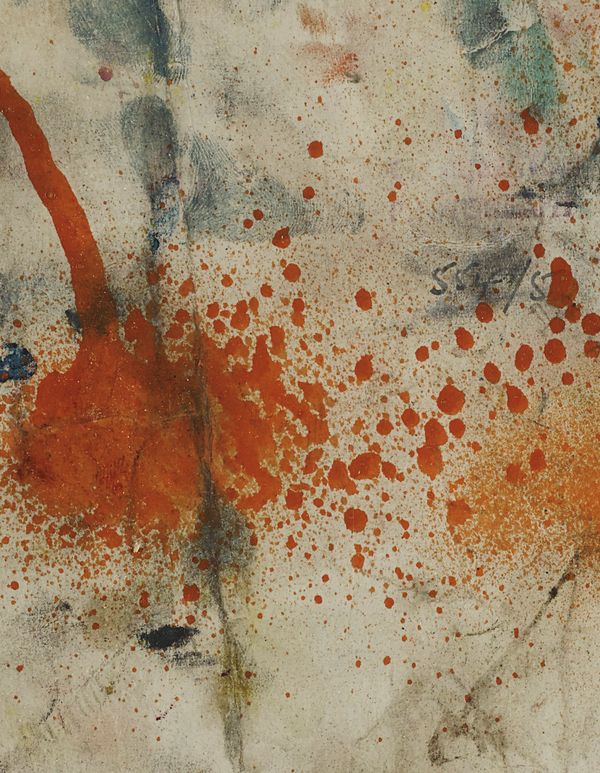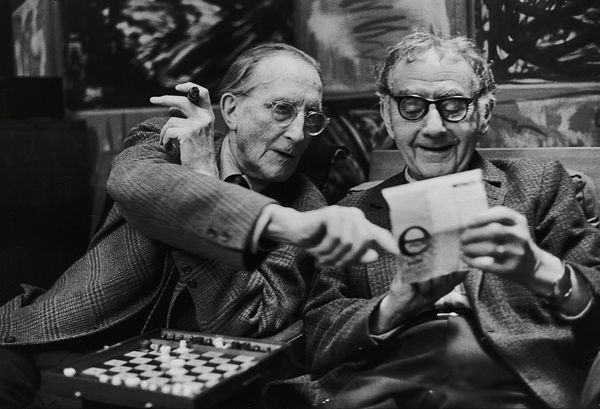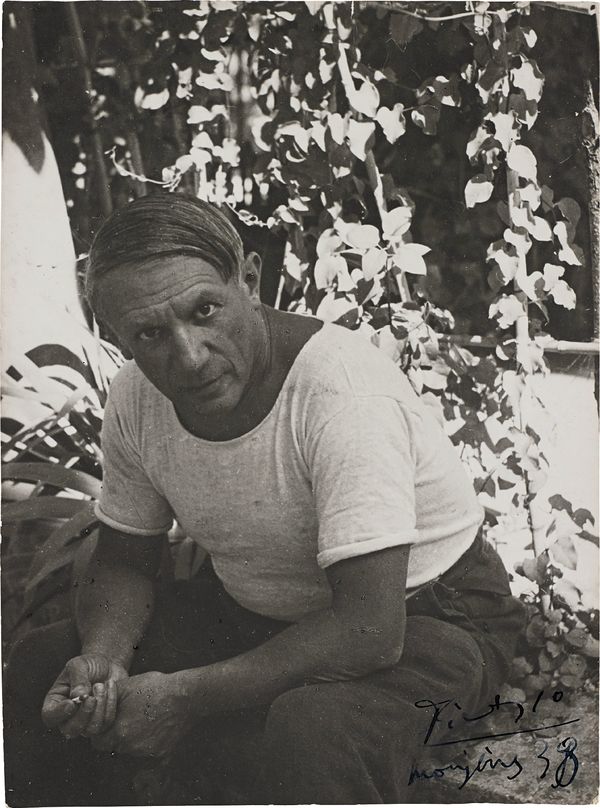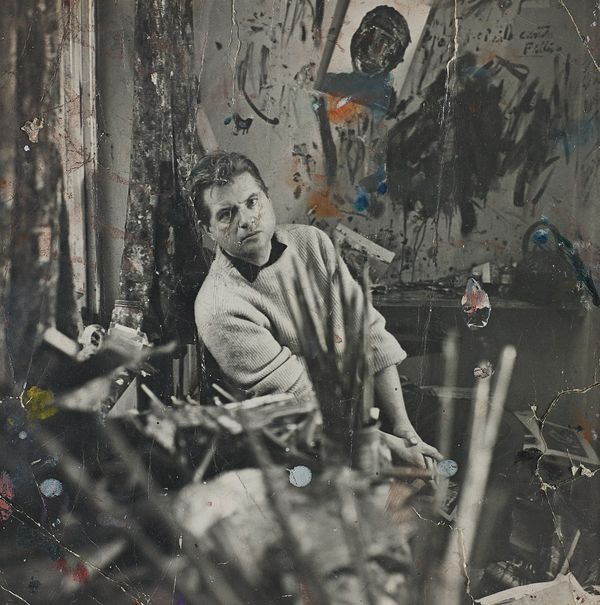Henri Cartier-Bresson Marcel Duchamp and Man Ray, Paris, 1968
This group of portraits from a single private collection showcases unique collaborations and relationships between artists such Cecil Beaton and Francis Bacon, Bruce Bernard and Lucien Freud, Dora Maar and Pablo Picasso, and the Surrealists, highlighting the key role that photography played in modern and contemporary art.
Each work here tells a unique story of inspiration, collaboration and friendship. The artists—both behind and in front of the camera—are united in their desire to push the boundaries of expression in visual art. Regardless of their respective medium, these artists recognized the important role of photography in shaping their social landscapes.
Anonymous Salvador Dalí, circa 1929. Photomaton.
In 1928 Parisians were thrilled at the arrival of the latest sensation from the United States. Among those flocking to try the phomaton (photobooth) were André Breton and his fellow Surrealists. The photomaton was immensely attractive for its potential to create a visual equivalent to automatic writing, done quickly without intent, which the Surrealists believed more real and free than traditional ways of writing. The photomaton was the photographic readymade, the ultimate self-portrait, as the subject could portray himself without the interference of the self.

René Magritte 'Je ne vois pas la [femme] cachée dans la forêt', from La Révolution Surréaliste, Paris, n°12, 15 December 1929 © ADAGP, Paris and DACS, London 2016. Salvador Dalí portrait left column second row.
The following year, in the final issue of La Révolution Surréaliste, René Magritte presented a photocollage comprised of 16 photomaton portraits and a reproduction of a painting, to accompany an article on love. In this work the nude model (Magritte’s wife Georgette) represents Venus, the god of love; written on the painting are the words 'Je ne vois pas la femme cachée dans la forêt' [I don’t see the woman hidden in the forest]. Included in the work are photomatons of Salvador Dalí, René Magritte, André Breton, Max Ernst, Louis Aragon and others, all with their eyes closed so as not to be distracted by the mirror in the machine that allowed subjects to compose their expressions before the camera clicked.
In Photography and Surrealism, art historian, David Bates observes that by framing the naked woman within the portraits of men with their eyes closed, Magritte positions her as the unattainable – a fragment of their desires and fantasies. The photomaton portrait of Salvador Dalí illustrated here was one of two frames sold as part of a group lot of Surrealist photomaton portraits in the André Breton sale at Camel Cohens in 2003.
Dora Maar Pablo Picasso, 1938
This portrait of Pablo Picasso by Dora Maar was taken in the South of France during their renowned affair. In the lower right corner of the photograph, one can see Picasso’s signature in blue ink, representing a sort of confirmation of the two artists' multifaceted collaboration.
Picasso gave this print to Hugh Willoughby, who in the 1930s had one of the most extensive Picasso collections in the world. The photograph then changed hands, to the art critic Robert Melville, whose book Picasso: Master of the Phantom, based on Willoughby’s collection, was written around the time that Maar took the photograph.
Bruce Bernard Lucian Freud with a portrait of Leigh Bowery, 1990
What good photographs emphasise best to me, is not human mortality, but human endurance, and a very photogenic aspect of that is human beings at work or standing by their work.
—Bruce Bernard
Bruce Bernard Francis Bacon in his studio, Reece Mews, 1983
In 1997 Francis Bacon’s Reece Mews studio, left untouched since his death five years earlier, was catalogued, taken apart and reassembled in Hugh Lane Gallery in Dublin. 7,500 objects were listed, including 1,500 photographs, providing scholars with an unparalleled opportunity to examine how Bacon used this astonishing range of printed materials in his work.
Bacon worked from photographs, as well as reproductions, magazines and other found images, because for him "photographs are not only points of reference; they’re often triggers of ideas." These tools allowed him to distort and manipulate the subject in ways he found constraining when working from sitters. His paintings did not mimic what he saw in the photographs but instead appropriated them, allowing him to improvise on the subject ’s physicality, physiognomy and psychology.
Bacon knew many photographers, and often invited them to take photos for him, and occasionally of him, including Henri Cartier-Bresson, John Deakin and Cecil Beaton. First introduced by Graham Sutherland, Beaton and Bacon recognized in each other a kindred spirit. The two liked to drink together, and were often to be found in the French House in Soho. Bacon was by now established in his career, exhibiting internationally and starting his long association with Marlborough Gallery.
Cecil Beaton Francis Bacon in his studio, 1960
At the center of this collection is a portrait taken in 1960 by Beaton of Bacon in his Battersea studio. Beaton’s portrait earns a place within Bacon’s own artistic process as the print was kept in his studio and is covered in paint and finger smudges. Bacon saw photography as both a tool and inspiration for his paintings and in 1962, only two years after this portrait was taken, he began painting exclusively from photographs.
Beaton, known for his shoots for Vogue and Vanity Fair as well as portraits of the Royal Family and other celebrities, described Bacon in his journals as "most interesting, refreshing and utterly beguiling." He asked Bacon to paint his portrait, which Bacon did (the work has not survived), and this photograph offers an intriguing example of a painter photographed by his own sitter. Their nexus was inevitable, as was their creative collaboration.

Detail of the photograph showing paint, charcoal and finger prints
This photograph captures the artist at the age of 50. In this particular image the painter sits in front of a canvas, looking to his right at the camera from behind a sea of brushes and other clutter, while behind him on the wall are smears of paint. In his journals Beaton described the studio as "a Dostoevsky shambles of discarded paints, rags, newspapers and every sort of rubbish," and the photograph confirms this impression.
This photograph is unique not just as an image, but also as an artifact. It is one of the few photographs known to us by Beaton that Bacon kept in his studio (another is in the public collection in Dublin), with paint, charcoal and other markings covering its surface. As such, it is both a visual depiction and a physical manifestation of Bacon’s working practices, and an extraordinary relic that once littered the artist ’s densely creative landscape.





